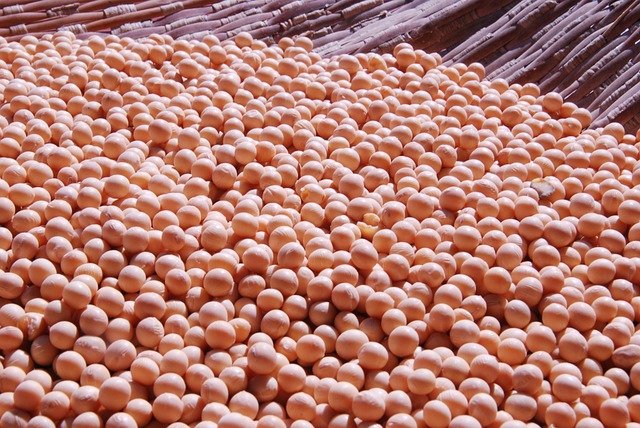
Soy lecithin is a compound contained in some foods and known for its ability to lower cholesterol, but not only. Let’s see what it is.
Soy lecithin is a substance contained in some foods that has peculiar characteristics that not only make it widely used as an additive in the food industry, but also make it a basic ingredient of many supplements useful for counteracting some pathological metabolic conditions, such as hypercholesterolemia. It has been the subject of scientific studies and is now widely used in various fields.
What is Soy Lecithin
From a chemical point of view, lecithin is a phospholipid, that is a lipid that has in its structure a part that is soluble in water and one that is soluble in fats and it is this particularity that gives lecithin important properties. In fact, it can be used as an emulsifying agent for fats and aqueous solutions, normally immiscible with each other.
Soy lecithin is a substance of vegetable origin, found in legumes and in particular in soy, from which it can be extracted mechanically or chemically. In the latter case, from the washed and peeled soy beans, through the use of chemical solvents, the crude oil is extracted which is separated from the bran, that is, from the solid part, which is usually dried and reduced to flour to be destined to animal husbandry. The crude oil is instead refined and in this process the lecithin is extracted with physical methods that involve heating with water and subsequent centrifugation, until a mass is obtained, which is dried to obtain the raw soy lecithin.
In order to be destined for food consumption, raw soy lecithin is subjected to further industrial processes for which in the end pure lecithin is obtained, in powder, which further processed can give rise to a product in granules.
Powdered soy lecithin can be used as an emulsifier, not only in industrial processes, but also at home to prepare creams and fillings, while the granulated one can be used as a supplement, since it has numerous beneficial properties. We also remember that soy lecithin does not contain cholesterol.
Soy lecithin: what is it for? Properties and benefits
Soy lecithin, as anticipated, is a substance that thanks to its properties is also used as a supplement since it offers benefits to our health. An important benefit, for example, concerns the cardiovascular system, the nervous system and health in menopause, but not only. So let’s see the properties of soy lecithin.
✓ Help against high cholesterol
It seems that soy lecithin can help reduce blood cholesterol levels as it favors the incorporation of excess cholesterol into HDL molecules, which, carrying it to the liver, promote its elimination. Furthermore, lecithin allows the synthesis of an enzyme capable of distributing cholesterol to tissues, thus reducing its level in the blood.
✓ Prevents the formation of gallstones
The presence of lecithin in the bile fluid is an important aid in preventing the formation of stones in the gallbladder since it is able to dissolve the excess cholesterol contained here.
✓ Strengthens the muscles
Lecithin is a phospholipid and phospholipids are the main constituents of cell membranes, therefore lecithin, providing material for the construction of new cells, is useful for our body for the proper functioning of all cells, even those of muscles.
✓ Contributes to the health of the nervous system
Some studies carried out on patients with Alzheimer’s disease or dementia show that lecithin is probably able to improve cognitive functions and memory. In fact, lecithin contains phosphatidylcholine, a precursor of the neurotransmitter acetylcholine.
✓ Useful in case of hyperglycemia
Soy lecithin contributes to lowering cardiovascular risk, which is often given by an association between various factors, including hypercholesterolemia, hypertriglyceridemia, diabetes and hypertension, so it could be a valuable aid to lower cardiovascular risk in the case of diabetes.
✓ Promotes weight loss
Soy lecithin stimulates metabolism as it is useful in the regeneration of muscle cells and counteracts the absorption of fats.
✓ Promotes digestion
Lecithin assists digestive processes, contributing to the proper functioning of the liver and gallbladder, it also helps intestinal motility by counteracting constipation.
✓ Relieves the symptoms of menopause
In menopause, soy lecithin helps to eliminate the sense of fatigue and regain physical strength, helping to repair damaged cell membranes. It also relieves other symptoms of menopause by lowering blood pressure.
✓ Counteracts osteoporosis
It seems that in association with soy isoflavones, lecithin is able to prevent bone demineralization that often occurs in menopause, thus helping to prevent osteoporosis.
✓ Useful for skin and hair health
Lecithin, helping to maintain the integrity of the biological membranes, also promotes the integrity of the skin barrier, helping to strengthen both the skin and the skin appendages, i.e. hair and nails, and to preserve the natural hydrolipidic protective film.
✓ Antioxidant properties
Given the content of vitamin E and linoleic acid, soy lecithin boasts antioxidant properties that once again contribute to the well-being of the cardiovascular system.
Soy lecithin in cooking: how to use it
Given its thickening and emulsifying properties, soy lecithin is widely used in cooking, for the preparation of creams and sauces and in pastry, for the creation of creams and foams. Soy lecithin is used, for example, to thicken creams and sauces or even to replace eggs in some preparations, such as for fresh pasta or pastry doughs, therefore useful for preparing the vegan version.
Furthermore, to favor the softness of homemade bread or leavened desserts such as brioches and panettone, it can be added to the dough in a proportion of 2% of the total flour. If soy lecithin is used as an emulsifier, it must be done cold because the heat alters its emulsifying properties.
Since, as mentioned, soy lecithin is a molecule found in vegetables and in particular in soy, if you want to take it to take advantage of its health benefits and not just as an ingredient in the kitchen, the recommended dose is from 5 to 10 grams per day, and taking into account that 100 grams of soy contains about 1.5 grams of lecithin, it is difficult to take this amount with food, so you should resort to taking it in the form of supplements.
Soy lecithin supplements: when and how to use them
Soy lecithin is marketed as a dietary supplement in various forms, for example as a powder, in granules or in soft gel pearls. If you choose the supplement in granules, you can use it by adding it to soups or to milk or yogurt, as it does not have a particular flavor. The daily dose can be divided into two or three administrations and preferably associated with meals, concomitantly with the intake of foods containing fat.
Naturally, as a supplement, soy lecithin should be taken when there is a real need, for example in the case of hypercholesterolemia associated with a high risk of cardiovascular diseases, but even in these cases, it is necessary that the intake takes place under advice and control. doctor. The intake of soy lecithin as a supplement, in fact, must be undertaken considering a series of factors, including the general state of health, any other pathologies and possible use of drugs, such as statins for hypercholesterolemia, because it could accentuate its effect.
Who shouldn’t take soy lecithin
If taken through food, soy lecithin has no particular contraindications, except, of course, a specific allergy, such as an allergy to soy.
If taken as a supplement, however, particular attention must be paid. First, any excess could cause gastrointestinal symptoms, such as abdominal pain, cramps, diarrhea, nausea, and lowering of blood pressure. Those who are already undergoing drug therapy for hypercholesterolemia or hypertriglyceridemia should ask their doctor before embarking on the use of soy lecithin as a supplement.
However, since soy lecithin is a derivative of soy, the contraindications of soy consumption are valid, so those with thyroid problems should be careful because the high consumption of soy could interfere with the functions of the thyroid and hormonal interference should also be taken into account of the phytoestrogens contained in soy.
Soy lecithin: where to buy it and which one to choose
We have seen that it is possible to find soy lecithin in various formulations (powder, granules, gel capsules and also in liquid form) and it is useful to underline that the powder and granule format is also considered a dietary supplement. Therefore, on medical advice, it is possible to buy soy lecithin in various formats by following the instructions given by the manufacturer for the dosage, also because, in some cases, the supplements may also contain additives.
Furthermore, since the extraction of lecithin from soy can occur in various ways, it would be better to choose a supplement in which the extraction was mechanical and not chemical. Soy lecithin does not contain gluten, so it is suitable for celiacs, but when buying it it is always advisable to read the nutritional label because in some formulations it may contain it. You can buy it at the supermarket, in health food stores, in drugstores and pharmacies or online.






